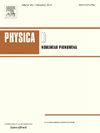Revisiting viscoelastic liquid films flowing down a slippery substrate: Linear and nonlinear viscoelastic waves
IF 2.9
3区 数学
Q1 MATHEMATICS, APPLIED
引用次数: 0
Abstract
This paper revisits the flow of a viscoelastic film on a slippery substrate (Phys. Rev. Fluids 7 (6), 064007, 2022) using the Navier-slip boundary condition, ( represents the friction coefficient of the substrate). Here, represents the total tangential shear stress, comprised of both a viscous and an elastic component. A model equation for the film thickness is derived based on the long-wave theory. The study investigates both the linear and nonlinear dynamics of the film flow. It reveals that the presence of a slippery substrate and viscoelasticity promote the instability of linear viscoelastic waves. Additionally, they affect the speed and height of nonlinear viscoelastic waves. Our present study suggests that neglecting the elastic component of at the slippery wall could result in an overestimation of the linear stability threshold while underestimating the speed and height of nonlinear waves.
重看沿光滑基底流动的粘弹性液体膜:线性和非线性粘弹性波
本文回顾了粘弹性膜在光滑基底上的流动(物理学。在Navier-slip边界条件下,τxz=λu (λ表示基片的摩擦系数)。在这里,τxz表示总切向剪应力,包括粘性和弹性分量。基于长波理论,推导了薄膜厚度的模型方程。研究了膜流的线性动力学和非线性动力学。结果表明,光滑基底和粘弹性的存在促进了线性粘弹性波的失稳。此外,它们还影响非线性粘弹性波的速度和高度。我们目前的研究表明,忽略光滑壁面处τxz的弹性分量可能会导致高估线性稳定阈值,而低估非线性波的速度和高度。
本文章由计算机程序翻译,如有差异,请以英文原文为准。
求助全文
约1分钟内获得全文
求助全文
来源期刊

Physica D: Nonlinear Phenomena
物理-物理:数学物理
CiteScore
7.30
自引率
7.50%
发文量
213
审稿时长
65 days
期刊介绍:
Physica D (Nonlinear Phenomena) publishes research and review articles reporting on experimental and theoretical works, techniques and ideas that advance the understanding of nonlinear phenomena. Topics encompass wave motion in physical, chemical and biological systems; physical or biological phenomena governed by nonlinear field equations, including hydrodynamics and turbulence; pattern formation and cooperative phenomena; instability, bifurcations, chaos, and space-time disorder; integrable/Hamiltonian systems; asymptotic analysis and, more generally, mathematical methods for nonlinear systems.
 求助内容:
求助内容: 应助结果提醒方式:
应助结果提醒方式:


